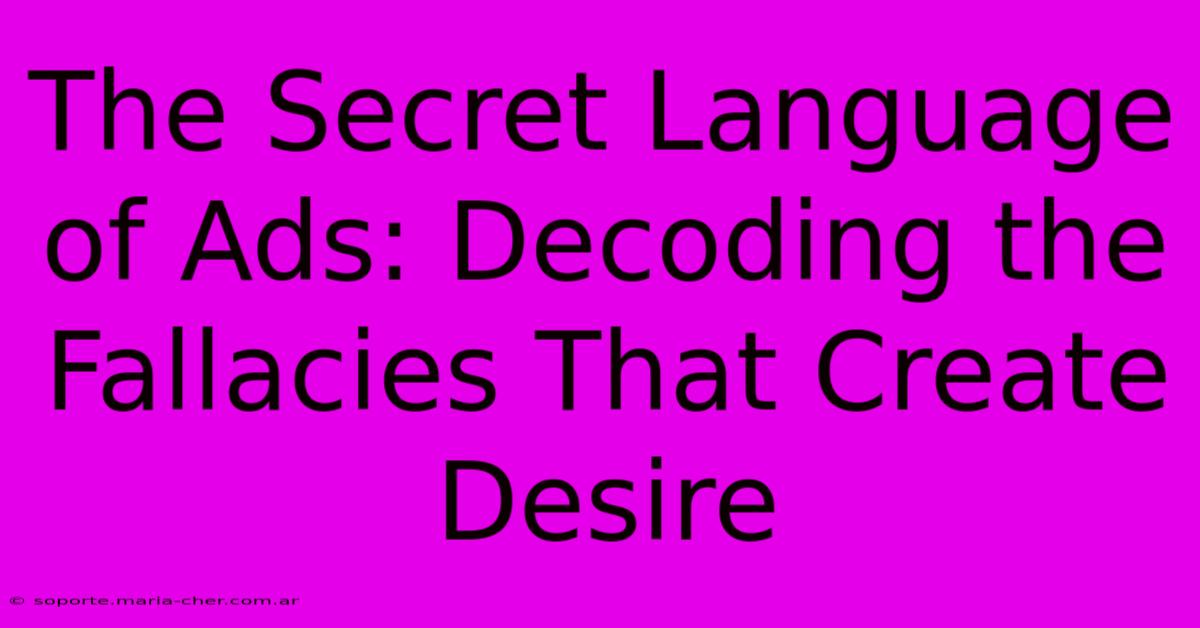The Secret Language Of Ads: Decoding The Fallacies That Create Desire

Table of Contents
The Secret Language of Ads: Decoding the Fallacies That Create Desire
Advertising is a powerful force shaping our desires and influencing our purchasing decisions. But how exactly do ads achieve this? They don't just tell us about a product; they weave a narrative, employing subtle psychological tricks and logical fallacies to create a compelling story that resonates with our deepest needs and wants. This article delves into the secret language of advertising, exposing the common fallacies that skillfully manipulate our desires and prompt us to buy.
Understanding the Psychology Behind Advertising
Before we dissect the fallacies, it's crucial to understand the underlying psychology. Advertisers tap into our emotions – fear, insecurity, ambition, and longing for belonging – to create a sense of urgency or desirability. They aim to connect their product with a positive feeling or the solution to a perceived problem, thereby forging a strong emotional link. This emotional connection often outweighs rational considerations.
The Power of Association and Storytelling
Advertising is masterful in using association. A product is linked to desirable lifestyles, attractive people, or exciting experiences. We're not just buying a car; we're buying freedom, adventure, and status. The narrative woven around the product is more important than the product itself. This storytelling technique helps create a memorable and emotionally resonant experience, embedding the product in our subconscious.
Decoding the Common Fallacies
Now let's explore some of the most prevalent logical fallacies used in advertising:
1. The Bandwagon Effect: "Everyone's Doing It!"
This fallacy leverages our inherent desire to conform. Ads frequently highlight the popularity of a product, implying that if everyone else is using it, it must be good. This plays on our fear of missing out (FOMO) and our social desire to belong. Statistics, testimonials, and images of crowds using the product are common tactics.
2. Appeal to Authority: "Experts Recommend..."
This tactic uses endorsements from celebrities, doctors, or other perceived experts to lend credibility to the product. We tend to trust authority figures, even if their expertise isn't directly relevant to the product. This fallacy bypasses critical thinking and encourages us to accept claims without rigorous scrutiny.
3. False Dilemma: "This or Nothing!"
This fallacy presents a limited choice, forcing consumers to select between the advertised product and an undesirable alternative. This creates a sense of urgency and eliminates other options from consideration. Nuance and alternative solutions are ignored to push a specific product.
4. Glittering Generalities: "Amazing! Revolutionary! Unbelievable!"
This involves using vague, positive words without providing concrete evidence. Terms like "amazing," "revolutionary," and "unbelievable" evoke strong emotions but lack substance. These emotionally charged words distract from the lack of factual support.
5. Red Herring: Distracting from the Real Issues
This fallacy diverts attention away from potential problems or shortcomings of the product by focusing on irrelevant aspects. For example, an ad might emphasize the sleek design of a car while ignoring its poor fuel economy or safety record. This cleverly shifts focus and avoids addressing crucial details.
6. Plain Folks Appeal: "Just Like You!"
This fallacy portrays the product as relatable and accessible to ordinary people. Ads might feature everyday individuals using the product, creating a sense of shared experience and familiarity. This tactic fosters trust and reduces the perceived distance between the consumer and the brand.
Becoming a More Critical Consumer
Understanding these advertising techniques empowers us to become more discerning consumers. By recognizing the fallacies at play, we can resist manipulative tactics and make informed purchasing decisions based on reason and genuine need, rather than emotional manipulation. Question claims, seek independent reviews, and compare products carefully. Don't let the secret language of ads dictate your desires – take control of your spending habits.
Keywords:
Advertising fallacies, advertising psychology, persuasive advertising, consumer behavior, marketing techniques, logical fallacies in advertising, bandwagon effect, appeal to authority, false dilemma, glittering generalities, red herring, plain folks appeal, critical consumer, decode advertising, understanding ads, advertising manipulation.
Conclusion:
The secret language of advertising is a complex blend of psychology and persuasive techniques. By understanding these strategies, we can become more informed and resilient consumers, making choices based on reasoned judgment rather than emotional manipulation. The power lies in our ability to critically analyze the messages we receive.

Thank you for visiting our website wich cover about The Secret Language Of Ads: Decoding The Fallacies That Create Desire. We hope the information provided has been useful to you. Feel free to contact us if you have any questions or need further assistance. See you next time and dont miss to bookmark.
Featured Posts
-
Heart Attack Hospitalization In Va A Financial Nightmare You Need To Prepare For
Feb 07, 2025
-
Reveal The Secret The Elegance Of Gold Vermeil Bracelets Unveiled
Feb 07, 2025
-
Urgent Care Relief Breaking Down The Costs With Insurance
Feb 07, 2025
-
Elevate Your Style With The Touch Of Gold The Essential Guide To Gold Vermeil Necklaces
Feb 07, 2025
-
Transform Your Text Into Visual Symphony The Art Of Baseline Alignment
Feb 07, 2025
